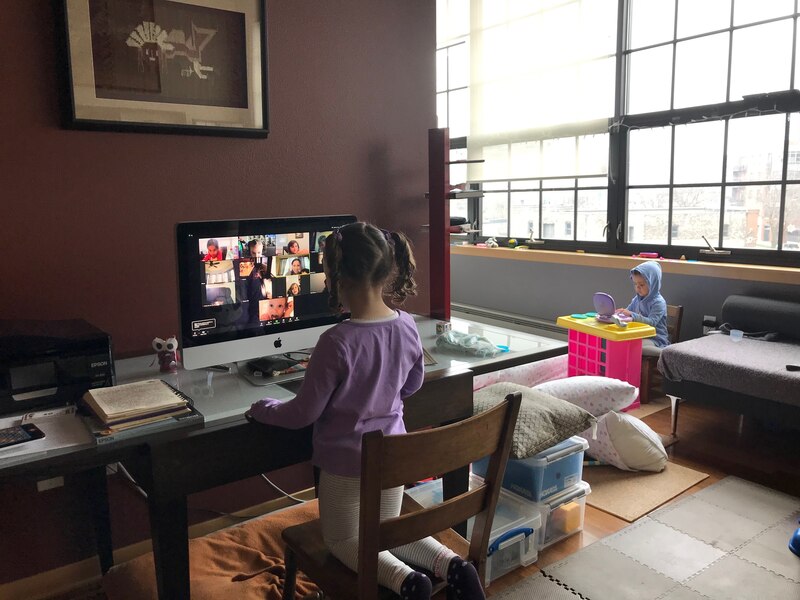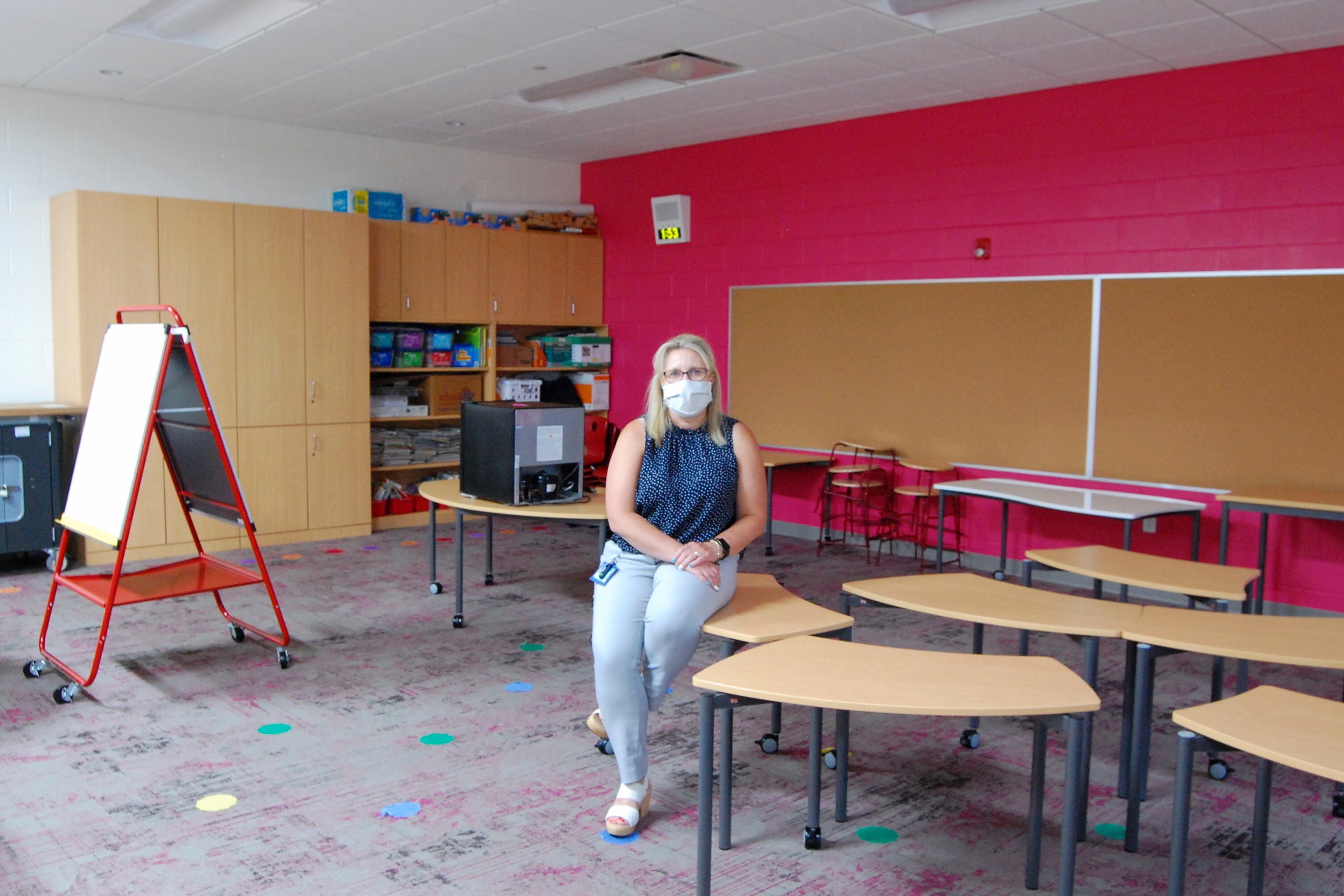At principal Aimee Kasper’s elementary school in Rockford, Illinois, students are used to moving the furniture around. Before the pandemic, first-graders would wheel curved tables that fit together like puzzle pieces when it was time to work in groups.
This September, the rolling tables will be locked in place. Seats will be assigned. And the cozy burgundy bean bag chairs will be gone — too difficult to disinfect — while thick tape will designate students’ personal space.
“That’s our plan for today,” Kasper said, though “things with COVID change by the minute.”
It’s all part of Rockford Public Schools’ strategy to safely serve the students whose families choose in-person instruction this fall — particularly its preschool and elementary school students, who will be able to come to school five days a week. The district of nearly 29,000 students in northern Illinois is prioritizing in-person time for younger students, with middle and high school students coming into buildings two days a week.
Bringing back the students least able to learn independently and who are less likely to transmit the virus may seem like a no-brainer, especially in places where virus caseloads are low enough to allow schools to open at all. But for now, the approach is still a relatively rare one, as district leaders are finding it comes with the standard challenges of reopening schools right now and some difficult additional tradeoffs.
“To me, it makes sense to focus on the youngest kids,” said Sarah Cohodes, an associate professor of economics and education at Columbia University’s Teachers College. But that doesn’t mean it’s simple to do so, she added. “Nobody wants to make the call that some students are going to get less than other students.”
Why some school districts are trying it
There are several reasons to prioritize younger students when schools reopen, though the science on this issue continues to evolve. Children younger than 10 appear to be less likely than older children, and much less likely than adults, to transmit the coronavirus — though some young children may still carry it at high levels. Children also seem to be less at risk of getting seriously ill from COVID-19.
Several countries brought back younger students first without triggering major outbreaks, though generally those places had much less community spread than the U.S. The idea has also been promoted by a host of pediatricians, economists, and writers on public health and education.
Some districts will offer younger students more in-person instructional time at the start of the school year. Other districts are planning to start the year remotely but plan to bring back younger students first, or have younger students eventually return for more time each week, including Palm Beach County, Florida; Jefferson County, Colorado; Kansas City, Missouri; New Orleans; and the Uncommon Schools charter network.
The primary reason: It’s particularly hard for virtual learning to approximate the academic and social environment of a classroom for young students.
That was the experience for Milwaukee parent Paola Schultz, whose 4-year-old at first was comforted by seeing her teachers virtually. But that only lasted a few weeks.

“Eventually there was a decreasing interest,” Schultz said, and she worried that her daughter’s ability to concentrate had diminished. (For now, Milwaukee schools are set to begin the year virtually, though officials are still considering bringing elementary-age children in five days a week later this fall.)
Elementary students also require much more adult help than their older peers. Some school districts, like Hillsborough County in Florida, have told families who choose a fully remote option this fall that they will be expected to provide daily guidance to their elementary-age child.
“This idea that remote learning can happen independent of the parent, especially for this pre-K to fifth grade age group, is not accurate,” said Alexis Lauricella, an assistant professor at Chicago’s Erikson Institute, an early education policy and teacher training center. “We need parent involvement at the bare minimum for the tech support, and especially as the kids are younger, for the processing.”
For some, the argument to prioritize elementary school students for in-person learning boils down to child care concerns.
In Amherst County, Virginia, the 4,000-student school district settled on a plan to bring preschool and elementary school students in four days a week after 44% of families of elementary-age students said in a survey that child care would be a significant concern if fully remote learning continued. School officials are offering middle and high school students two days a week of in-person instruction.
“Parents don’t have any good options,” said Rob Arnold, the district’s superintendent. He knows some are “deciding not to work and staying at home with their students.”
Child care was a pressing concern in Colorado’s Jeffco Public Schools, too. The suburban Denver district that serves some 84,000 students will start the year remotely, but plans to offer elementary school students five days a week of in-person instruction when case numbers decline, while middle and high school students would attend on alternating days.
Superintendent Jason Glass said the district’s plans for elementary schoolers were also influenced by research on child transmission rates and state guidance that encourages schools to bring elementary students back for in-person learning. There’s also the fact that it’s easier to create self-contained groups of students and staff in elementary schools.
“Typically you’ve got a teacher that works with one group of kids all day,” Glass said. “It’s much easier to do at the elementary level than at the high school level, where you’ve got multiple instructors, kids taking all sorts of classes.”
And in Rockford, Kasper hopes that by offering in-person instruction, teachers at her school, where 91% of students come from low-income families, can reconnect with the dozens of students who did not turn in any work and did not respond to phone calls or home visits since school buildings closed in mid-March.
“We don’t know if they’re OK, and that worries us,” she said.
Why it can be hard to pull off
But there are still many challenges to bringing younger students back, including the same logistical hurdles of planning for any school reopening, such as convincing teachers and parents that in-person instruction is safe.
That’s hard to do right now. In many parts of the country, COVID-19 cases are continuing to rise, and school and health officials have decided not to open schools physically, despite the Trump administration’s push for schools to fully reopen. Teachers in a number of cities and states have called for a remote start to the school year.
California is letting school districts reopen elementary schools in counties that are otherwise restricted by their virus caseloads, but only after they submit an application, publish a plan, and meet with various groups, like parents and teachers unions.
And despite the need for child care, several national surveys and polls have shown that a majority of parents, especially Black and Latino parents, are wary of sending their children back into school buildings.
“I have mixed feelings,” Denver parent Nallely Antúnez Gonzalez told Chalkbeat last week, after the district decided it would hold classes remotely until mid-October. Her children, who are headed into kindergarten and second grade, struggled to learn online this spring, but she also worries that young children would struggle to follow strict health rules and that people might get sick if everyone returns. “It’s complicated,” she said.
Then there are questions of whether and how to rearrange classes.
Durham Public Schools, which serves 33,000 students in North Carolina, will teach students remotely for the first nine weeks of school, but if public health conditions improve, officials plan to spread elementary and middle school students across all of the district’s school buildings, with high school students continuing to learn online.
“Our leadership team felt that our younger students were the most vulnerable and our older students, while still vulnerable, stood the best chance of prospering under remote instruction,” said William Sudderth, a district spokesperson.
Still, Sudderth notes “the challenges are significant” with that plan. Bus routes would have to shift, elementary and middle school staff may have to travel farther to work, and meals would have to be delivered to new locations. A plan like that is also likely to require an overhaul of space and furniture. High school desks, for example, are way too big for first-graders.
In Colorado’s Jeffco Public Schools, Glass says district officials contemplated but eventually discarded a similar idea.
“The problem with that is now I can’t offer any in-person experiences for my middle and high school kids,” Glass said. “All the same equity concerns I had are present with them, as well.”
There are other reasons districts have decided against this idea. Some are prioritizing in-person learning for other groups, such as students with disabilities, English learners, and students who weren’t able to participate much in remote learning this spring, either because they lacked the technology or had other responsibilities at home.
If a district prioritizes one age group over another, it can also lead to concerns about fairness. In Chicago, for example, the district had planned to offer most elementary and middle school students two days a week of in-person instruction, while high school juniors and seniors would be fully remote. But officials said they would reconsider that plan after many families of older students said they wanted some in-person instruction, too. (The district is now set to start the year virtually.)
It’s hard to prioritize younger children in a district where middle and high school students also found it hard to “learn online or who have experienced trauma at home,” said Cohodes of Teachers College.
And then, of course, there is the overall concern that students and staff could get sick.
In Rockford, some teachers have called on the district to start the year fully remotely, and the testing positivity rate is on the rise — though it’s not at the 5% threshold that federal health officials have cited as what constitutes a “hot spot.”
That’s put a lot of pressure on Kasper, who says she has been up all night for weeks running through the school day, planning all of the necessary changes to keep her students and staff safe.
“We need our babies here for their learning to be optimized,” she said. “It’s a big weight on our shoulders.”
This story was updated on August 5, 2020 to include Chicago Public Schools’ decision to start the school year virtually.








